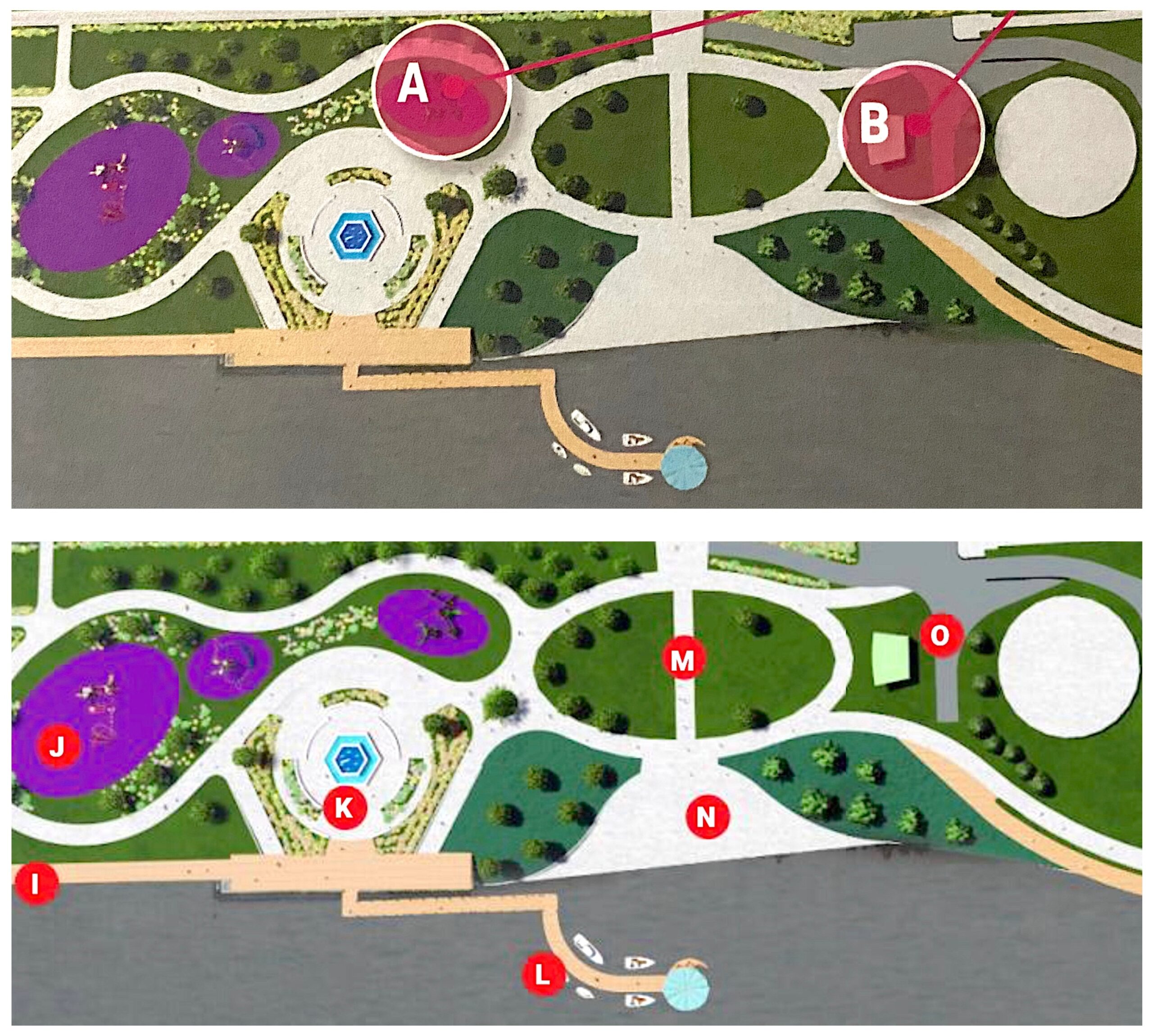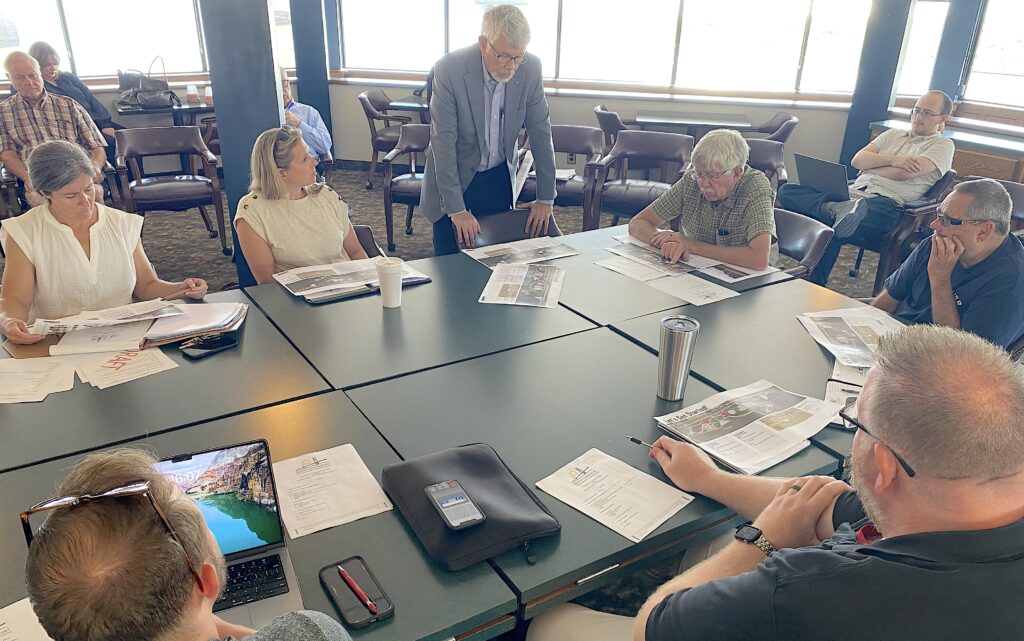Riverfront Development Corporation takes first step in plan to use $350,000 grant for interactive play area

QUINCY — The Quincy Riverfront Development Corporation voted unanimously during its Wednesday afternoon meeting at the Quincy Boat Club to spend $10,000 with Klingner and Associates, an architecture and engineering company, to update the Riverfront Master Plan if necessary.
It’s the first step toward the corporation’s plan to build an interactive play area — originally planned to be north of the gazebo in Clat Adams Park — on a lot just north of an inoperative sludge pump station.
The idea of the interactive play area (don’t call it a “splash pad” anymore) was introduced at the corporation’s Aug. 28 meeting. Mike Klingner, president of Klingner and Associates, made a presentation on Wednesday to the corporation showing options for the location of an interactive play area. Klingner explained the first step was for the corporation to agree to spend the money to change the master plan.
Community Development Planner Jason Parrott said he doesn’t yet know for certain that $10,000 cost will be covered by a $350,000 grant secured by three years ago by State Sen. Jil Tracy from the Department of Commerce and Economic Opportunity. The Riverfront Development Corporation’s vote essentially provided a backup plan to pay Klingner and Associates.
The next step will be for the corporation to spend approximately $107,000 for planning and design work for the interactive play area’s new location. The state grant would cover that cost, leaving approximately $233,000 to go toward the interactive play area.
Klingner said to expect a proposal for the interactive play area to cost between $750,000 to $1 million. He suggested that the play area be built in sections, allowing the Riverfront Corporation’s foundation more time to raise money.
“(This is) bare bones (compared to) what we’re seeing in (similar play areas in) other small communities,” he said. “They’re spending $400,000 to $500,000 just on water park features without getting into some of the fancier and active things. Hopefully we can get grant money for them to do that.”

Klingner offered two sites for the location of the interactive play area. Corporation members didn’t take an official vote, but several expressed their wish to put it next near the site of the sludge dome instead of just to west of the Clat Adams gazebo. One of the advantages of building it near the sludge dome is that 30 parking stalls already are nearby.
Klingner explained that using industrial concepts (such as pumps and stoves) “of what made Quincy what it is” would be made into features in the planned play area, along with the water features. He hoped the foundation could secure grant money or money from existing industries.
“The planning department and the engineering department are suggesting the planning would include whatever we’re going to eventually build there, but you wouldn’t be able to do it all at once,” Klingner said. “You’d have to phase it in based on the availability of funds.
“If you want to make that change in the master plan, then we can start from there to get something in place. We can’t do too much with $350,000, so we’re going to need some additional fundraising to do very much at all. … Maybe you just get it started and make sure we don’t lose that $350,000 and, meanwhile, try to look at other avenues to raise funds to get something bigger down there.”
Director of Planning Chuck Bevelheimer said he’s talked with Quincy Park District officials about the interactive play area, and he said they were “open” to the project.
Klingner also suggested the possibility of the interactive play area using fresh water from the wastewater treatment plant, then letting it go back to the plant. He said other cities with water features on the riverfront have additional expenses when re-treating the water used. Bevelheimer said it would be more cost-effective to use fresh water.
“We could get things started by the city of Quincy offering the water,” Klingner said. “I don’t know if you could offer the water for free.”
“You’re kind of putting me on the spot,” Bevelheimer said.
“That’s to be negotiated,” Mayor Mike Troup said. “Water is available. Just look out your windows.”
Troup said the plans could eventually allow for recycling water at the play area.
“To avoid having to put bathrooms in, we could do it in phases,” he said. “We would initially just let the water drain out, and then as part of the (future) enhancements, we could add the filtration system when we’re adding restrooms down in that area.”
Corporation member Mike Mahair said the foundation — comprised of Troup, Klingner, Mahair, Hal Oakley and Jeff Grimm — wanted to take the lead on the fundraising for this project. When Mahair asked if the foundation had raised any funds, Troup replied, “We don’t have a project. That’s why you need to tell us what project you want so we can tell people what we’re raising money for.”
Not discussed during the meeting was the cost of demolishing the sludge dome.
The Quincy City Council defeated by a 7-6 vote on Monday night a resolution that would have used money from the city’s water fund to pay for razing the sludge dome and allowed the Quincy Riverfront Development Corporation to keep all of its $350,000 grant for what was at the time a yet-to-be-determined project. Alderman Mike Rein (R-5) Rein said after the meeting he doesn’t want money spent by people paying water usage rates to pay for the demolition when the state grant is available to pay for it.
Asked how the sludge dome demolition would be paid for, Bevelheimer said with a smile, “That is a work in progress. The goal all along was to use the water fund money. We’re going to have to go back to the aldermen. I can’t tell you we’ve got that crafted yet.”
The plan for how to spend the grant money has changed for a third time. It originally was to be spent on buying power lines on the riverfront, then it was to be spent on an event plaza.
“The scope of work in engineering design (for the event plaza) came out to be a $3 million cost,” Bevelheimer said. “We’re like, wait a minute, that’s not going to work. So then we said, ‘OK, we’ve got to rethink our plan.’ When we bid out the dome (demolition), it came in so low. We said, ‘Let’s do something we can actually get our hands on and raise money for.’ Like the mayor said, we’ve got to have a project that we can point to and say, ‘This is what the Riverfront Foundation is for.’”
Tieraney Craig, president of the Riverfront Corporation, was hopeful after the meeting that the right project has finally been selected.
“I think the interactive play area will get the most bang for the buck,” she said. “We need to listen to what the public wants.”
“We believe that with the efforts of the board, looking at this, it all seems to be coming together, that this is a more feasible project,” Parrott said. “If you can show a picture of an interactive play area versus the idea of, ‘We’re going to fill in some dirt in this area. We’re going to bury power lines,’ which one is somebody going to jump at? We think we know that’s where they’re going to jump.”
Miss Clipping Out Stories to Save for Later?
Click the Purchase Story button below to order a print of this story. We will print it for you on matte photo paper to keep forever.

